change time FIAT TALENTO 2020 Owner handbook (in English)
[x] Cancel search | Manufacturer: FIAT, Model Year: 2020, Model line: TALENTO, Model: FIAT TALENTO 2020Pages: 236, PDF Size: 4.86 MB
Page 2 of 236

We really know your vehicle because we invented,
designed and built it: we really know every single detail. At Fiat Professional Service authorised workshops you can find technicians directly trained by us, offering quality and pr\
ofessionalism for all service operations.
Fiat Professional workshops are always close to you for the regular serv\
icing operations, season checks and practical recommendations by our experts.
With Fiat Professional Genuine Parts you keep the reliability, comfort a\
nd performance features of your new vehicle unchanged in time: that's why you bought it for.
Always ask for Genuine Parts for the components used on our vehicles; we\
recommend them because they come from our steady commitment in research and development of highly innovative t\
echnologies. For all these reasons: rely on Genuine Parts,
because they are the only ones designed by Fiat Professional for your ve\
hicle.
WHY CHOOSING GENUINE PARTS
SAFETY: BRAKING
SYSTEMENVIRONMENT: PARTICULATE FILTERS,
CLIMATE CONTROL SYSTEM MAINTENANCECOMFORT:
SUSPENSION AND WINDSCREEN WIPERSPERFORMANCE:
SPARK PLUGS, INJECTORS AND BATTERIESLINEACCESSORI:
ROOF RACK BARS, WHEEL RIMS
COP TALENTO LUM GB.qxp 29/04/16 12:11 Pagina 2
Page 6 of 236
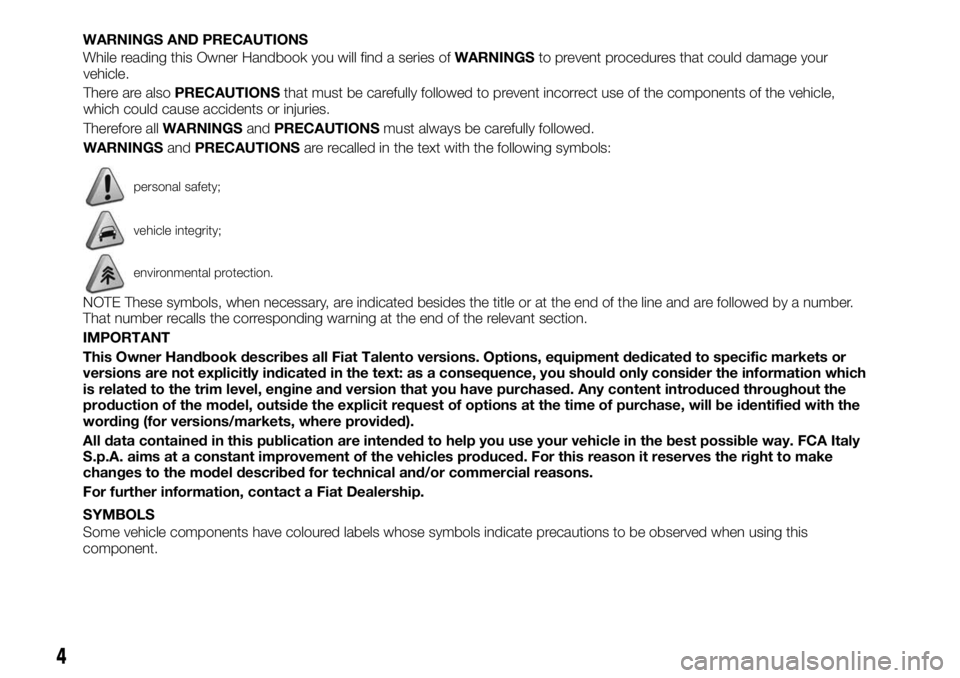
WARNINGS AND PRECAUTIONS
While reading this Owner Handbook you will find a series ofWARNINGSto prevent procedures that could damage your
vehicle.
There are alsoPRECAUTIONSthat must be carefully followed to prevent incorrect use of the components of the vehicle,
which could cause accidents or injuries.
Therefore allWARNINGSandPRECAUTIONSmust always be carefully followed.
WARNINGSandPRECAUTIONSare recalled in the text with the following symbols:
personal safety;
vehicle integrity;
environmental protection.
NOTE These symbols, when necessary, are indicated besides the title or at the end of the line and are followed by a number.
That number recalls the corresponding warning at the end of the relevant section.
IMPORTANT
This Owner Handbook describes all Fiat Talento versions. Options, equipment dedicated to specific markets or
versions are not explicitly indicated in the text: as a consequence, you should only consider the information which
is related to the trim level, engine and version that you have purchased. Any content introduced throughout the
production of the model, outside the explicit request of options at the time of purchase, will be identified with the
wording (for versions/markets, where provided).
All data contained in this publication are intended to help you use your vehicle in the best possible way. FCA Italy
S.p.A. aims at a constant improvement of the vehicles produced. For this reason it reserves the right to make
changes to the model described for technical and/or commercial reasons.
For further information, contact a Fiat Dealership.
SYMBOLS
Some vehicle components have coloured labels whose symbols indicate precautions to be observed when using this
component.
4
Page 41 of 236
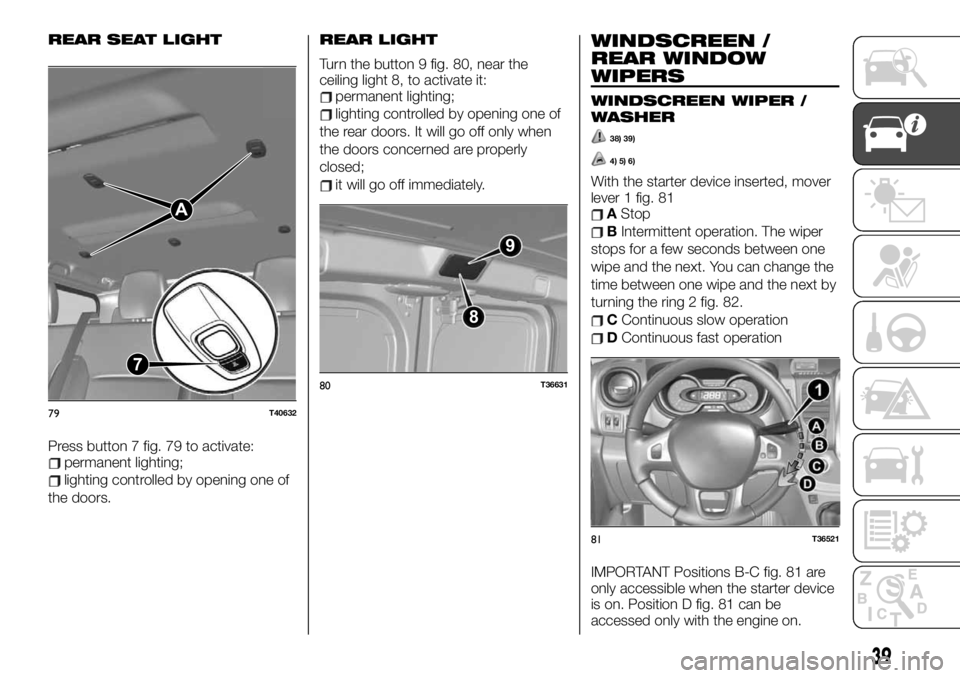
REAR SEAT LIGHT
Press button 7 fig. 79 to activate:permanent lighting;
lighting controlled by opening one of
the doors.
REAR LIGHT
Turn the button 9 fig. 80, near the
ceiling light 8, to activate it:
permanent lighting;
lighting controlled by opening one of
the rear doors. It will go off only when
the doors concerned are properly
closed;
it will go off immediately.
WINDSCREEN /
REAR WINDOW
WIPERS
WINDSCREEN WIPER /
WASHER
38) 39)
4) 5) 6)
With the starter device inserted, mover
lever 1 fig. 81
AStop
BIntermittent operation. The wiper
stops for a few seconds between one
wipe and the next. You can change the
time between one wipe and the next by
turning the ring 2 fig. 82.
CContinuous slow operation
DContinuous fast operation
IMPORTANT Positions B-C fig. 81 are
only accessible when the starter device
is on. Position D fig. 81 can be
accessed only with the engine on.
7A
79T40632
89
80T36631
81T36521
39
Page 42 of 236
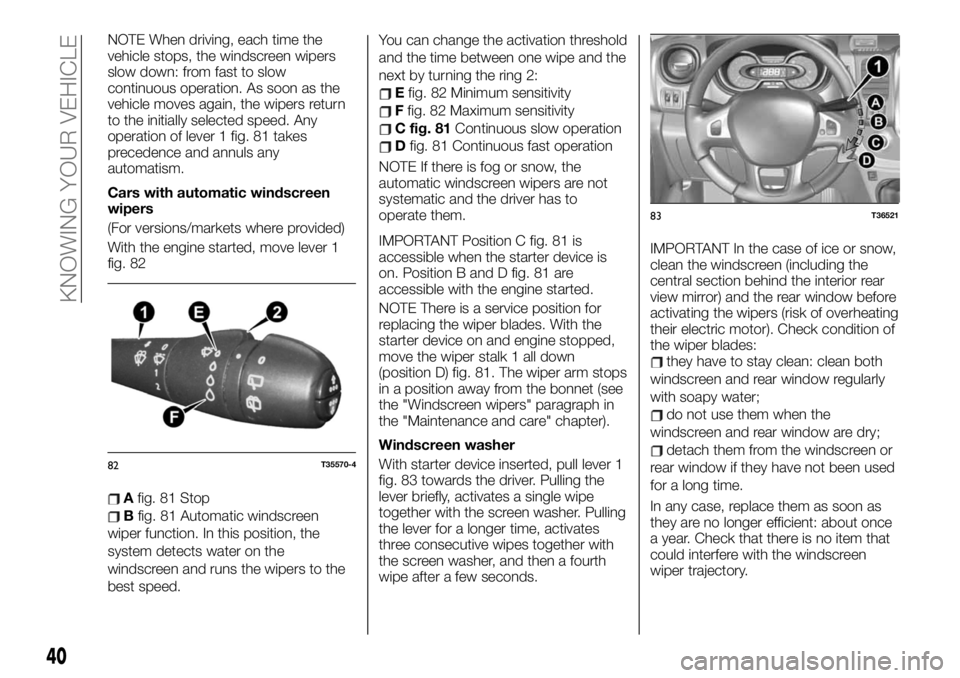
NOTE When driving, each time the
vehicle stops, the windscreen wipers
slow down: from fast to slow
continuous operation. As soon as the
vehicle moves again, the wipers return
to the initially selected speed. Any
operation of lever 1 fig. 81 takes
precedence and annuls any
automatism.
Cars with automatic windscreen
wipers
(For versions/markets where provided)
With the engine started, move lever 1
fig. 82
Afig. 81 Stop
Bfig. 81 Automatic windscreen
wiper function. In this position, the
system detects water on the
windscreen and runs the wipers to the
best speed.You can change the activation threshold
and the time between one wipe and the
next by turning the ring 2:
Efig. 82 Minimum sensitivity
Ffig. 82 Maximum sensitivity
C fig. 81Continuous slow operation
Dfig. 81 Continuous fast operation
NOTE If there is fog or snow, the
automatic windscreen wipers are not
systematic and the driver has to
operate them.
IMPORTANT Position C fig. 81 is
accessible when the starter device is
on. Position B and D fig. 81 are
accessible with the engine started.
NOTE There is a service position for
replacing the wiper blades. With the
starter device on and engine stopped,
move the wiper stalk 1 all down
(position D) fig. 81. The wiper arm stops
in a position away from the bonnet (see
the "Windscreen wipers" paragraph in
the "Maintenance and care" chapter).
Windscreen washer
With starter device inserted, pull lever 1
fig. 83 towards the driver. Pulling the
lever briefly, activates a single wipe
together with the screen washer. Pulling
the lever for a longer time, activates
three consecutive wipes together with
the screen washer, and then a fourth
wipe after a few seconds.IMPORTANT In the case of ice or snow,
clean the windscreen (including the
central section behind the interior rear
view mirror) and the rear window before
activating the wipers (risk of overheating
their electric motor). Check condition of
the wiper blades:
they have to stay clean: clean both
windscreen and rear window regularly
with soapy water;
do not use them when the
windscreen and rear window are dry;
detach them from the windscreen or
rear window if they have not been used
for a long time.
In any case, replace them as soon as
they are no longer efficient: about once
a year. Check that there is no item that
could interfere with the windscreen
wiper trajectory.
82T35570-4
83T36521
40
KNOWING YOUR VEHICLE
Page 56 of 236

IMPORTANT Vehicles equipped with
the ECOMODE function (button 9
fig. 96 ): when enabled, the ECOMODE
function can reduce the automatic
climate control system performance.
Please see the paragraph "Driving
suggestions".
Internal air recirculation
This function is managed automatically,
but you can also enable it manually. It
can be forced on by button 7 fig. 95,
which is highlighted by the button’s led
turning on
IMPORTANT In any case,
de-misting/defrosting takes priority over
air recycling.
Note:
during recycling, the air in the
passenger compartment is recycled
without introducing outside air;
air recirculation lets you isolate the
interior from outside influences (driving
in a polluted area, e.g.);
to get the desired internal passenger
compartment temperature more
quickly.
Manual use: Press button 7
fig. 95 and the integrated warning light
will go on.
Prolonged use of the recirculation
function can create unpleasant odours
and mist up the windows as the air is
not changed.We advise you to return to automatic
mode by pressing button 7 fig. 95 again
as soon as air recirculation is no longer
needed.
Press button 7 fig. 95 again to
deactivate the this function.
System deactivation
Turn control 6 fig. 95 to the OFF
position to deactivate the system. To
turn it on again, turn control 6
fig. 95 again to adjust the fan speed, or
press button 1 fig. 95.
ADDITIONAL CLIMATE
CONTROL
(For versions/markets where provided)
If equipped with them, the vehicle has
four diffusers that can be aimed, 1
fig. 97.
These controls only act on the amount
of air in the passenger compartment:
one control for heat (air coming out
of the lower diffusers);
one control for cold (air coming out
of the upper diffusers).
NOTE Do not close all four diffusers at
the same time (you risk damaging the
system components).Vehicles with manual air
conditioning
Make sure the air conditioning is
working (LED on button 2 fig. 98 on).
IMPORTANT Pressing button 2
fig. 98 the led turns on:
when the led is on, the function is on;
when the led is off, the function is off.
97T36557
98T36643
54
KNOWING YOUR VEHICLE
Page 89 of 236
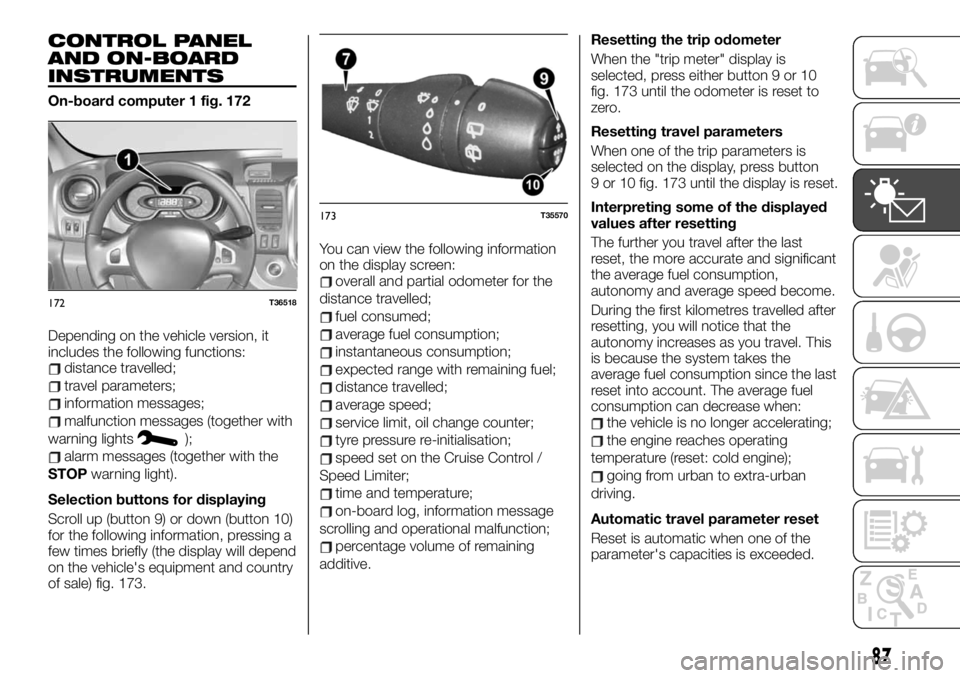
CONTROL PANEL
AND ON-BOARD
INSTRUMENTS
On-board computer 1 fig. 172
Depending on the vehicle version, it
includes the following functions:
distance travelled;
travel parameters;
information messages;
malfunction messages (together with
warning lights
);
alarm messages (together with the
STOPwarning light).
Selection buttons for displaying
Scroll up (button 9) or down (button 10)
for the following information, pressing a
few times briefly (the display will depend
on the vehicle's equipment and country
of sale) fig. 173.You can view the following information
on the display screen:
overall and partial odometer for the
distance travelled;
fuel consumed;
average fuel consumption;
instantaneous consumption;
expected range with remaining fuel;
distance travelled;
average speed;
service limit, oil change counter;
tyre pressure re-initialisation;
speed set on the Cruise Control /
Speed Limiter;
time and temperature;
on-board log, information message
scrolling and operational malfunction;
percentage volume of remaining
additive.Resetting the trip odometer
When the "trip meter" display is
selected, press either button 9 or 10
fig. 173 until the odometer is reset to
zero.
Resetting travel parameters
When one of the trip parameters is
selected on the display, press button
9 or 10 fig. 173 until the display is reset.
Interpreting some of the displayed
values after resetting
The further you travel after the last
reset, the more accurate and significant
the average fuel consumption,
autonomy and average speed become.
During the first kilometres travelled after
resetting, you will notice that the
autonomy increases as you travel. This
is because the system takes the
average fuel consumption since the last
reset into account. The average fuel
consumption can decrease when:
the vehicle is no longer accelerating;
the engine reaches operating
temperature (reset: cold engine);
going from urban to extra-urban
driving.
Automatic travel parameter reset
Reset is automatic when one of the
parameter's capacities is exceeded.
172T36518
173T35570
87
Page 92 of 236
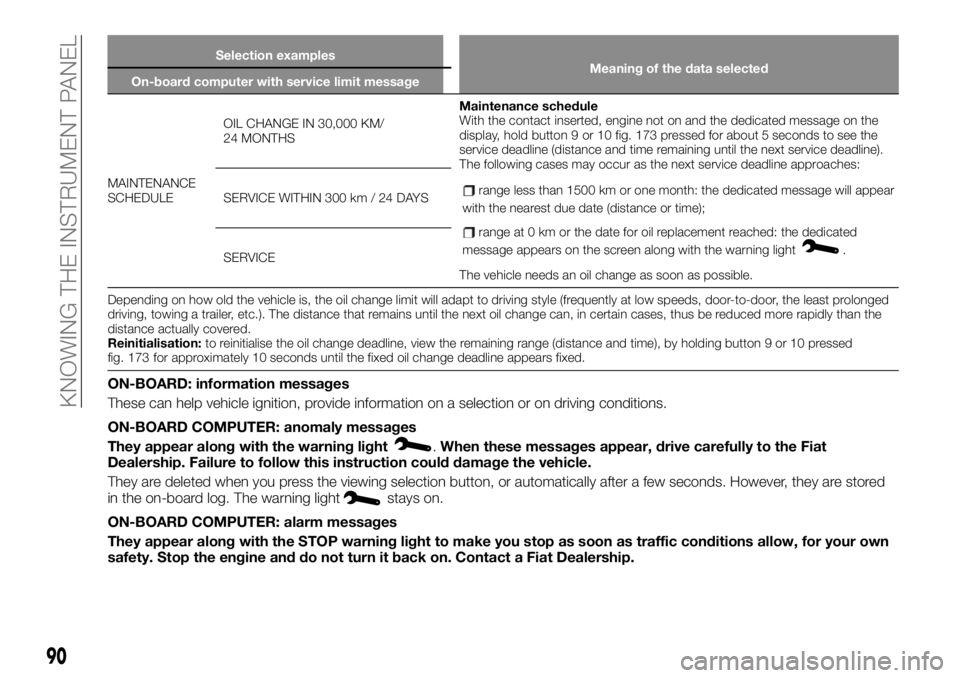
Selection examples
Meaning of the data selected
On-board computer with service limit message
MAINTENANCE
SCHEDULEOIL CHANGE IN 30,000 KM/
24 MONTHSMaintenance schedule
With the contact inserted, engine not on and the dedicated message on the
display, hold button 9 or 10 fig. 173 pressed for about 5 seconds to see the
service deadline (distance and time remaining until the next service deadline).
The following cases may occur as the next service deadline approaches:range less than 1500 km or one month: the dedicated message will appear
with the nearest due date (distance or time);
range at 0 km or the date for oil replacement reached: the dedicated
message appears on the screen along with the warning light .
The vehicle needs an oil change as soon as possible. SERVICE WITHIN 300 km / 24 DAYS
SERVICE
Depending on how old the vehicle is, the oil change limit will adapt to driving style (frequently at low speeds, door-to-door, the least prolonged
driving, towing a trailer, etc.). The distance that remains until the next oil change can, in certain cases, thus be reduced more rapidly than the
distance actually covered.
Reinitialisation:to reinitialise the oil change deadline, view the remaining range (distance and time), by holding button 9 or 10 pressed
fig. 173 for approximately 10 seconds until the fixed oil change deadline appears fixed.
ON-BOARD: information messages
These can help vehicle ignition, provide information on a selection or on driving conditions.
ON-BOARD COMPUTER: anomaly messages
They appear along with the warning light
.When these messages appear, drive carefully to the Fiat
Dealership. Failure to follow this instruction could damage the vehicle.
They are deleted when you press the viewing selection button, or automatically after a few seconds. However, they are stored
in the on-board log. The warning light
stays on.
ON-BOARD COMPUTER: alarm messages
They appear along with the STOP warning light to make you stop as soon as traffic conditions allow, for your own
safety. Stop the engine and do not turn it back on. Contact a Fiat Dealership.
90
KNOWING THE INSTRUMENT PANEL
Page 136 of 236
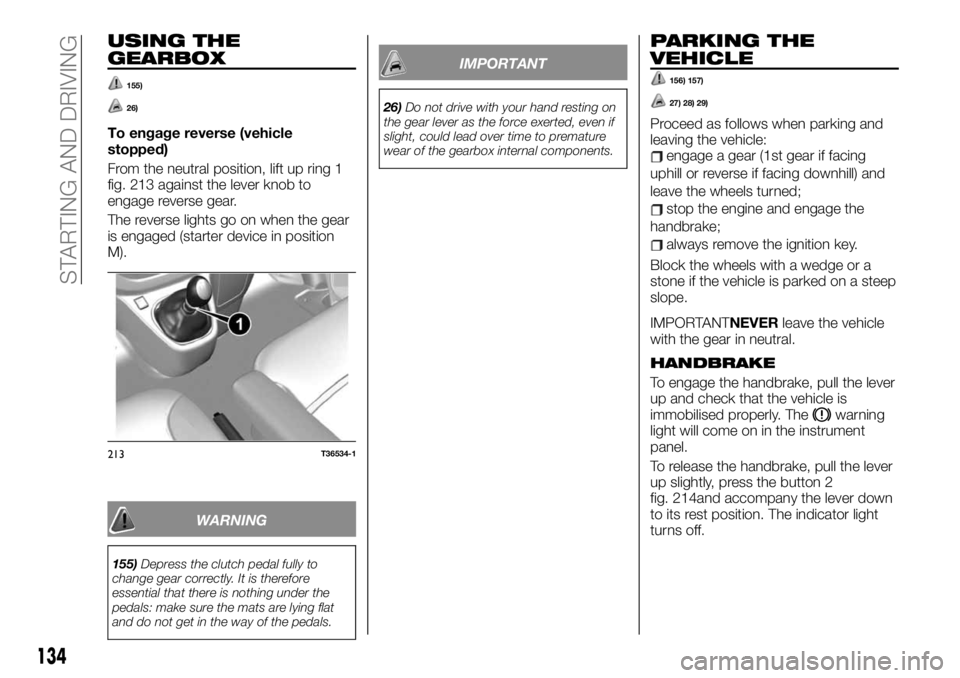
USING THE
GEARBOX
155)
26)
To engage reverse (vehicle
stopped)
From the neutral position, lift up ring 1
fig. 213 against the lever knob to
engage reverse gear.
The reverse lights go on when the gear
is engaged (starter device in position
M).
WARNING
155)Depress the clutch pedal fully to
change gear correctly. It is therefore
essential that there is nothing under the
pedals: make sure the mats are lying flat
and do not get in the way of the pedals.
IMPORTANT
26)Do not drive with your hand resting on
the gear lever as the force exerted, even if
slight, could lead over time to premature
wear of the gearbox internal components.
PARKING THE
VEHICLE
156) 157)
27) 28) 29)
Proceed as follows when parking and
leaving the vehicle:
engage a gear (1st gear if facing
uphill or reverse if facing downhill) and
leave the wheels turned;
stop the engine and engage the
handbrake;
always remove the ignition key.
Block the wheels with a wedge or a
stone if the vehicle is parked on a steep
slope.
IMPORTANTNEVERleave the vehicle
with the gear in neutral.
HANDBRAKE
To engage the handbrake, pull the lever
up and check that the vehicle is
immobilised properly. The
warning
light will come on in the instrument
panel.
To release the handbrake, pull the lever
up slightly, press the button 2
fig. 214and accompany the lever down
to its rest position. The indicator light
turns off.
213T36534-1
134
STARTING AND DRIVING
Page 141 of 236
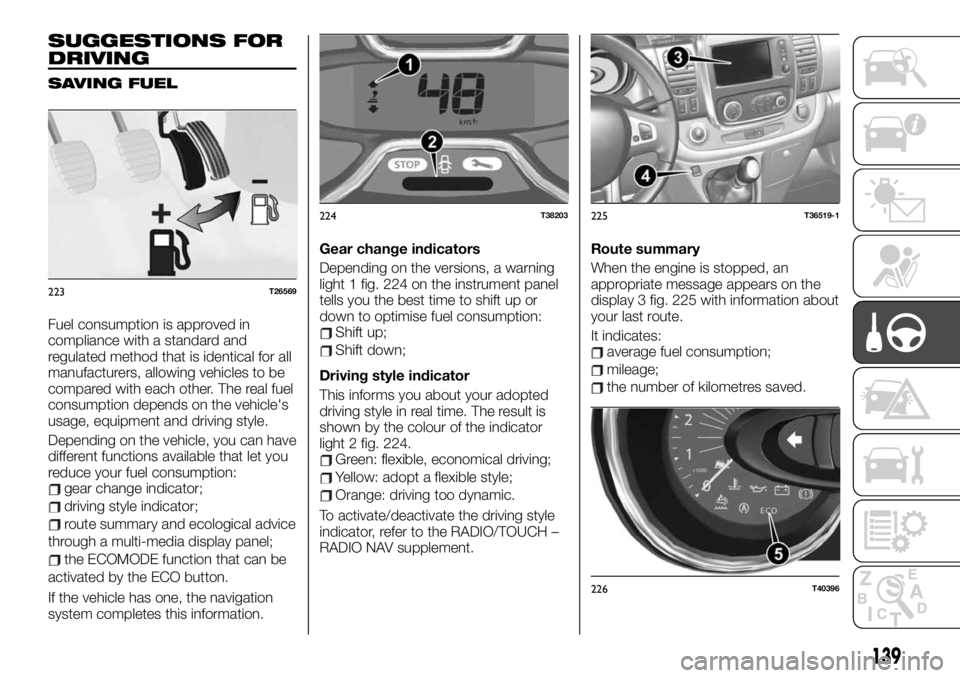
SUGGESTIONS FOR
DRIVING
SAVING FUEL
Fuel consumption is approved in
compliance with a standard and
regulated method that is identical for all
manufacturers, allowing vehicles to be
compared with each other. The real fuel
consumption depends on the vehicle's
usage, equipment and driving style.
Depending on the vehicle, you can have
different functions available that let you
reduce your fuel consumption:
gear change indicator;
driving style indicator;
route summary and ecological advice
through a multi-media display panel;
the ECOMODE function that can be
activated by the ECO button.
If the vehicle has one, the navigation
system completes this information.Gear change indicators
Depending on the versions, a warning
light 1 fig. 224 on the instrument panel
tells you the best time to shift up or
down to optimise fuel consumption:
Shift up;
Shift down;
Driving style indicator
This informs you about your adopted
driving style in real time. The result is
shown by the colour of the indicator
light 2 fig. 224.
Green: flexible, economical driving;
Yellow: adopt a flexible style;
Orange: driving too dynamic.
To activate/deactivate the driving style
indicator, refer to the RADIO/TOUCH –
RADIO NAV supplement.Route summary
When the engine is stopped, an
appropriate message appears on the
display 3 fig. 225 with information about
your last route.
It indicates:
average fuel consumption;
mileage;
the number of kilometres saved.
223T26569
224T38203225T36519-1
226T40396
139
Page 172 of 236
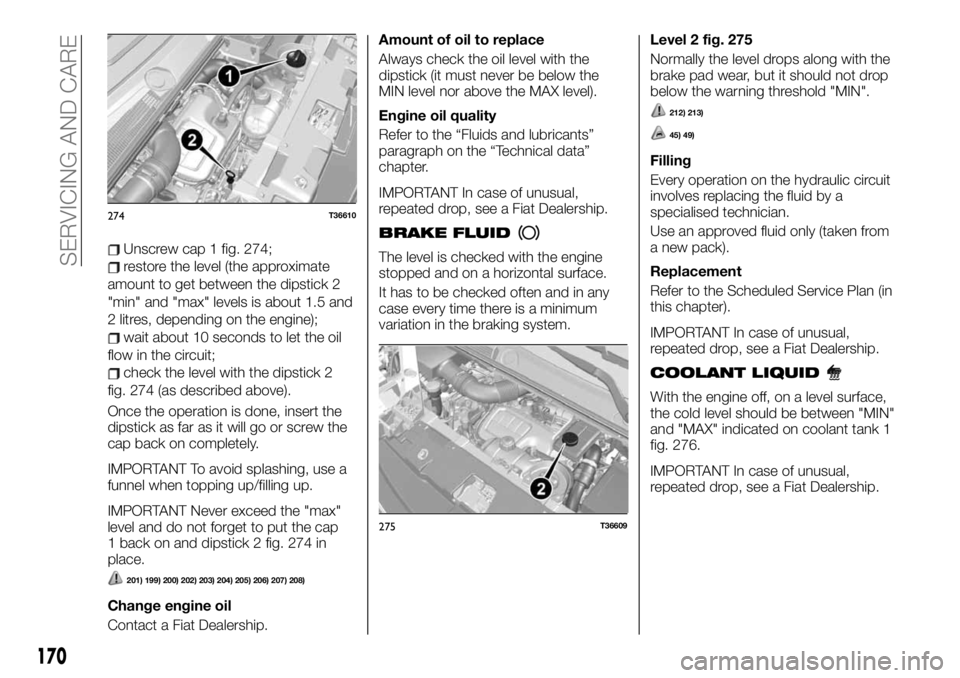
Unscrew cap 1 fig. 274;
restore the level (the approximate
amount to get between the dipstick 2
"min" and "max" levels is about 1.5 and
2 litres, depending on the engine);
wait about 10 seconds to let the oil
flow in the circuit;
check the level with the dipstick 2
fig. 274 (as described above).
Once the operation is done, insert the
dipstick as far as it will go or screw the
cap back on completely.
IMPORTANT To avoid splashing, use a
funnel when topping up/filling up.
IMPORTANT Never exceed the "max"
level and do not forget to put the cap
1 back on and dipstick 2 fig. 274 in
place.
201) 199) 200) 202) 203) 204) 205) 206) 207) 208)
Change engine oil
Contact a Fiat Dealership.Amount of oil to replace
Always check the oil level with the
dipstick (it must never be below the
MIN level nor above the MAX level).
Engine oil quality
Refer to the “Fluids and lubricants”
paragraph on the “Technical data”
chapter.
IMPORTANT In case of unusual,
repeated drop, see a Fiat Dealership.
BRAKE FLUID
The level is checked with the engine
stopped and on a horizontal surface.
It has to be checked often and in any
case every time there is a minimum
variation in the braking system.Level 2 fig. 275
Normally the level drops along with the
brake pad wear, but it should not drop
below the warning threshold "MIN".
212) 213)
45) 49)
Filling
Every operation on the hydraulic circuit
involves replacing the fluid by a
specialised technician.
Use an approved fluid only (taken from
a new pack).
Replacement
Refer to the Scheduled Service Plan (in
this chapter).
IMPORTANT In case of unusual,
repeated drop, see a Fiat Dealership.
COOLANT LIQUID
With the engine off, on a level surface,
the cold level should be between "MIN"
and "MAX" indicated on coolant tank 1
fig. 276.
IMPORTANT In case of unusual,
repeated drop, see a Fiat Dealership.
274T36610
275T36609
170
SERVICING AND CARE